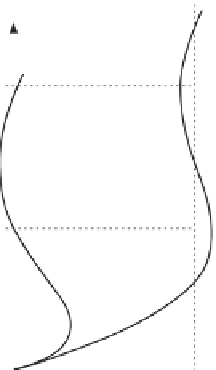Geoscience Reference
In-Depth Information
(a)
z/D
2
v
(b)
u
1
v
u
u
g
Figure 3.9
Ekman veering caused by bed friction acting on a geostrophic flow. (a) Vertical
profiles of the u and v components of current; (b) the hodograph of the current vector. Adapted
from (Kundu and Cohen,
2008
), courtesy of Academic Press.
In the bottom layer, the x and y equations of motion for steady flow are just:
0
@
1
t
x
@
0
¼
fv
z
ð
3
:
45
Þ
0
@
1
t
y
@
0
@
1
p
0
@
1
t
y
@
0
¼
fu
z
y
¼
fu
z
þ
fu
g
@
where we have used
Equation (3.44)
to substitute for the pressure gradient. Expressing
the stresses above in terms of the velocity shear and an eddy viscosity
(Equation 3.40)
,
we have:
2
u
N
z
@
þ
z
2
¼
fv
0
@
ð
3
:
46
Þ
2
v
N
z
@
f
ð
u
u
g
Þþ
z
2
¼
0
:
@
For boundary conditions we have: at the bottom boundary u
¼
v
¼
0atz
¼
0. Far
above the bottom, the motion is just the geostrophic flow u
.
With these conditions, the solution to
Equations (3.46)
is (e.g. Kundu,
1990
, see p. 622):
¼
u
g
; v
¼
0atz
¼1
e
z
=
D
cos
u
g
e
z
=
D
sin
u
¼
u
g
1
ð
z
=
D
Þ
;
v
¼
ð
z
=
D
Þ
ð
3
:
47
Þ
which is in the form of the steady current plus a spiral similar to that which we saw
at the surface. The spiral rotates clockwise with increasing height above bottom
(northern hemisphere). A plot of the boundary currents (steady current
spiral)
from
Equation (3.47)
is shown in
Fig. 3.9
. Close to the bed and continuing up to a
þ




























Search WWH ::

Custom Search